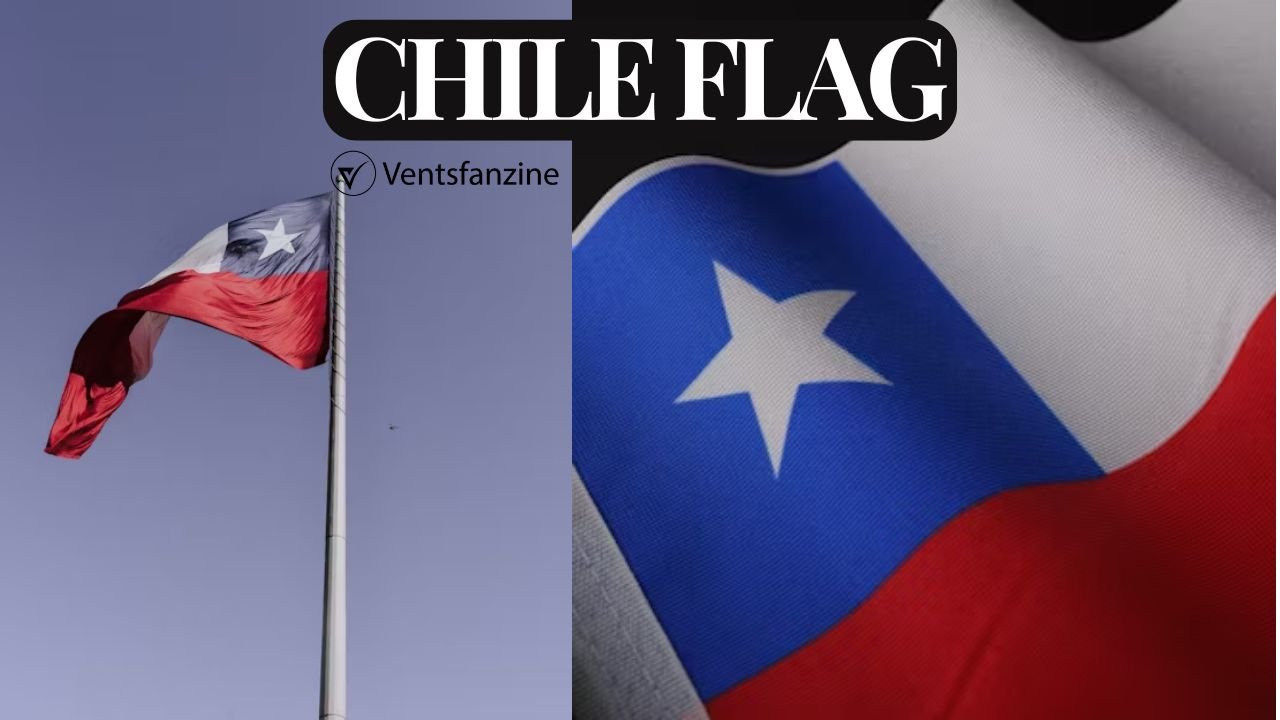Introduction
The Chile Flag, called “La Estrella Solitaria” (The Lone Star), is a mighty symbol of the dominion’s identity, data, and aspirations. Composed of horizontal bands of white and red with a blue square and a white famous individual within the canton, this flag encapsulates the spirit and values of Chileans. In this whole article, we can delve into the records, symbolism, layout, and cultural importance of the Chile Flag, exploring its evolution and the function it plays within the country-wide attention.
Historical Significance of the “Lone Star”
The 5-pointed celebrity on the Chile Flag, referred to as the “Lone Star,” is steeped in historic significance. This megastar changed into decided to represent steerage and improvement, comparable to the North Star guiding sailors. During Chile’s battle for independence, the superstar symbolized a beacon of choice and the relentless pursuit of sovereignty. Over time, it has emerged as a long-lasting brand of the country’s aspirations and willpower to concord.
The Flag as a Rallying Symbol in Protests
The flag of Chile has played a pivotal function in political moves and protests all through the US’s history. From the pupil protests worrying about instructional reform to demonstrations advocating for human rights and social justice, the flag is a common sight. It serves as an effective image of collective movement and the quest for alternate, embodying human beings’s voice and their needs for a higher society.
The Flag During Pinochet’s Regime
During General Augusto Pinochet’s military dictatorship (1973-1990), the flag of Chile took on complicated political connotations. While it remained a national image, its use with the aid of the regime to sell nationalism became arguable. In this era, competition organizations additionally followed the flag to indicate their resistance, consequently reworking it right into a photo of each oppression and wish for liberation.
Independence Day Festivities
Chile’s Independence Day celebrated on September 18, is marked using grand festivities where the flag takes center degree. Known as “Fiestas Patrias,” these celebrations characteristic parades, conventional dances, and communal gatherings, all embellished with national shades. The flag’s presence for the duration of those events fosters a feeling of countrywide pride and team spirit amongst Chileans.
The Flag in Regional Festivals
Beyond country-wide holidays, the Chile Flag is prominently displayed in nearby fairs, reflecting the cultural range inside the United States of America. These festivals rejoice in neighborhood traditions and background, with the flag symbolizing the unifying thread that binds the various areas collectively. It acts as a reminder of the shared countrywide identification amidst close-by range.
Teaching National Identity in Schools
In Chilean colleges, the Chile Flag is an important part of schooling on national identity. Students are taught the history and significance of the flag from an early age, instilling an enjoyment of patriotism and recognition. Classroom sports often encompass drawing the flag, singing the countrywide anthem, and mastering the heroes of independence, reinforcing the flag’s role in shaping country-wide recognition.
Flag Ceremonies in Educational Institutions
Flag ceremonies are a common exercise in Chilean educational institutions. These ceremonies, which normally involve the elevating and decreasing of the flag, are accomplished with high-quality reverence and are often accompanied by patriotic songs and recitations. They serve as an everyday reminder of the kingdom’s values and the importance of civic duty.
The Flag in Visual Arts
The Chile Flag has been a source of ideas for numerous visual artists. Its formidable colors and iconic layout are regularly included in artwork, works of art, and sculptures. Artists use the flag to bring subjects of country-wide delight, historical reminiscence, and social observation, making it a powerful device for innovative expression.
Literary References to the Flag
In Chilean literature, the Chile Flag is regularly referenced as a symbol of identity and resilience. Poets and novelists have used the imagery of the flag to rouse feelings of patriotism, critique political regimes, and find out the complexities of countrywide identity. The flag serves as a literary motif that connects personal narratives to the broader national tale.
Diplomatic Representation of the Flag
The Chile Flag plays a vital feature in international diplomacy. It is prominently displayed at embassies and consulates globally, symbolizing Chile’s sovereignty and its diplomatic presence. The flag is also a fixture at international summits and conferences, representing Chile in a worldwide place and reinforcing its identification on the sector degree.
The Flag at Sports Competitions
In sports competitions, the Chile Flag is a symbol of national pleasure and a useful resource. Whether at the Olympics, the FIFA World Cup, or nearby tournaments, Chilean athletes and supporters proudly wave the flag. Its presence at these activities galvanizes national cohesion and showcases Chile’s competitive spirit and determination to excellence.
The Flag During Natural Disasters
Chile is prone to herbal screw-ups consisting of earthquakes and tsunamis. In the aftermath of such occasions, the flag will become a picture of resilience and team spirit. It is frequently displayed all through recuperation efforts, reminding residents of their power and concord in the face of adversity. The flag’s presence inspires desire and collective movement to rebuild and get better.
The Flag in Social Movements
The flag of Chile has been a picture of resilience in social moves advocating for various reasons, from indigenous rights to environmental protection. Activists use the flag to awareness of their dedication to one’s troubles, emphasizing the connection between their struggles and the wider national identity. The flag for this reason becomes a banner of perseverance and social justice.
Laws Governing Flag Use
The use of the Chile Flag is blanketed through specific legal guidelines that make certain it is treated with recognition and dignity. These legal guidelines define the right display, managing, and disposal of the flag. For instance, the flag needs to in no manner touch the floor, be used for business capabilities, or be displayed in a tattered condition. These policies hold the flag’s integrity as a country’s extensive image.
Penalties for Flag Misuse
Penalties for violating flag guidelines can encompass fines and, in intense times, imprisonment. These stringent measures reflect the significance positioned at the flag as a photo of national unity and pride. By implementing those laws, Chile guarantees that the flag remains a respected and respected brand of the state.
The Flag in Social Media
In the age of digital media, the Chile Flag has found a new platform for expression. Social media structures are flooded with pictures of the flag in the path of national celebrations, protests, and massive events. Hashtags associated with the flag and countrywide satisfaction trend in the course of key moments, amplifying the flag’s role in fostering an experience of community and national identity online.
The Flag in National Mourning
The flag of Chile moreover holds a solemn position in the course of times of national mourning. When tragedies strike, whether or not or no longer because of herbal disasters, accidents, or the passing of great national figures, the flag is flown at half-mast as a mark of understanding and harmony. This gesture symbolizes the dominion’s collective grief and its capability to come again together in instances of sorrow. The visible impact of the flag at 1/2-mast serves as a poignant reminder of the lives misplaced and the resilience of the Chilean humans in the face of adversity. National ceremonies frequently consist of the flag as a crucial detail.
The Flag in International Aid and Solidarity
Chile’s involvement in global resource and solidarity efforts is regularly followed through the presence of its countrywide flag. During international humanitarian missions or global peacekeeping efforts, the Chile Flag is displayed to indicate the US’s commitment to worldwide peace and welfare. This use of the flag extends Chile’s values of justice, compassion, and international cooperation beyond its borders. For instance, at some point of natural screw-ups in other global places, Chilean aid employees often bring the flag as a picture of their nation’s aid. This reinforces the concept that the Chile Flag isn’t always the best marker of countrywide identity but additionally an image of world solidarity and humanitarian effort.
The Flag in Chilean Military Traditions
In the Chilean military, the flag holds a function of extreme honor and recognition. Military gadgets supply the flag throughout parades, true ceremonies, and state features, showcasing their allegiance and determination to the dominion. The flag is prominently featured in military insignia and decorations, symbolizing the bravery and sacrifice of Chilean soldiers. Additionally, recruits often take an oath of loyalty to the flag, reinforcing their determination to guard and serve the United States of the United States. This ritual not handiest strengthens the bond between the infantrymen and their United States but also underscores the significance of the flag as an image of responsibility, honor, and patriotism inside the navy network.
The Flag’s Influence on Popular Culture
The impact of the Chile Flag extends deeply into the area of famous lifestyle. Its colors and logos appear in a wide variety of media, which includes movies, track films, and style. Artists and architects frequently draw thought from the flag, using its imagery to create works that resonate with national satisfaction and identity. In track, well-known songs frequently reference the flag, evoking emotions of harmony and patriotism. Films and television shows set in Chile generally feature the flag as a backdrop, reinforcing its function within the countrywide narrative. This pervasive presence in the popular way of life helps to preserve the flag relevant and ingrained inside the regular lives of Chileans, constantly reinforcing its importance across generations.
The Flag’s Role in Educational Curricula
In Chile, the flag is a crucial part of the instructional curriculum, used to educate students approximately national records, geography, and civic obligation. Lessons approximately the flag’s origins, its symbolism, and its characteristics in considerable historical events are blanketed into diverse topics, offering university college students a whole expertise of their country beyond. Schools frequently prepare sports collectively with flag-raising ceremonies, essay competitions on patriotic subjects, and artwork duties centered throughout the flag. These educational practices goal to instill a revel in satisfaction and apprehend country-wide symbols from a more youthful age. By incorporating the flag into each day’s day-to-day lifestyles, educators make certain that scholars build a deep, lasting connection to their U.S.A.’s values and records.
Conclusion
The flag of Chile, with its rich ancient importance and profound symbolism, serves as an effective brand of national identity and concord. From its position in political moves and national celebrations to its presence in training, paintings, and global diplomacy, the flag embodies the spirit and values of Chilean humans. It stands as a living photograph of resilience, satisfaction, and the continuous pursuit of progress, reinforcing a feeling of belonging and collective cause among Chileans. As Chile continues to adapt, the flag will live a number one and enduring instance of the nation’s background and aspirations.
FAQs
1. What does the massive name on the Chile Flag constitute?
The 5-pointed movie star on the Chile Flag, called the “Lone Star,” symbolizes steerage and development, similar to the North Star guiding sailors. It represents a beacon of desire and the relentless pursuit of sovereignty at some point in Chile’s war for independence.
2. When is the Chile Flag prominently displayed?
The Chile Flag is prominently displayed all through countrywide holidays inclusive of Independence Day (September 18), local festivals, political actions, and sports activities and competitions. It is likewise featured in educational settings, army traditions, and instances of country-wide mourning.
3. What are the legal pointers regarding the use of the Chile Flag?
Chilean regulation ensures the flag is treated with recognition and dignity. The flag ought to in no manner contact the ground, be used for business functions, or be displayed in a tattered situation. Violations can bring about fines and, in excessive times, imprisonment.
4. How is the flag used in Chilean education?
The flag is a quintessential part of the instructional curriculum in Chile. Students study its history, importance, and role in national occasions. Schools conduct flag-elevating ceremonies and different sports to instill a feeling of patriotism and respect for national symbols.
5. What function does the Chile Flag play in global international relations?
The Chile Flag represents the state within the international area. It is displayed at embassies, consulates, and international summits, symbolizing Chile’s sovereignty and diplomatic presence. The flag is likewise used during international aid missions and peacekeeping efforts.











